FIN200 Assignment T1 2018: Superannuation Plan Comparison Report
VerifiedAdded on 2021/05/31
|8
|2604
|37
Report
AI Summary
This report, prepared for a FIN200 assignment, provides a detailed analysis of superannuation plans in Australia, focusing on the comparison between defined benefit and investment choice plans. The introduction highlights the government's emphasis on superannuation for retirement and the mandatory employer contributions. The main body of the report delves into the characteristics of defined benefit plans, including how benefits are calculated based on final salary and years of service, and the implications of unfunded schemes. It also explores investment choice plans, detailing the various investment options available and their associated risks and returns. The report further examines the factors to consider when making superannuation decisions, such as inflation, the time value of money, and taxation, including tax offsets for senior citizens. The conclusion emphasizes that the choice between the plans depends on an individual's risk tolerance and financial objectives. The report references various academic sources to support its findings, making it a valuable resource for students studying finance and superannuation.

FIN200 Assignment T1, 2018
Paraphrase This Document
Need a fresh take? Get an instant paraphrase of this document with our AI Paraphraser
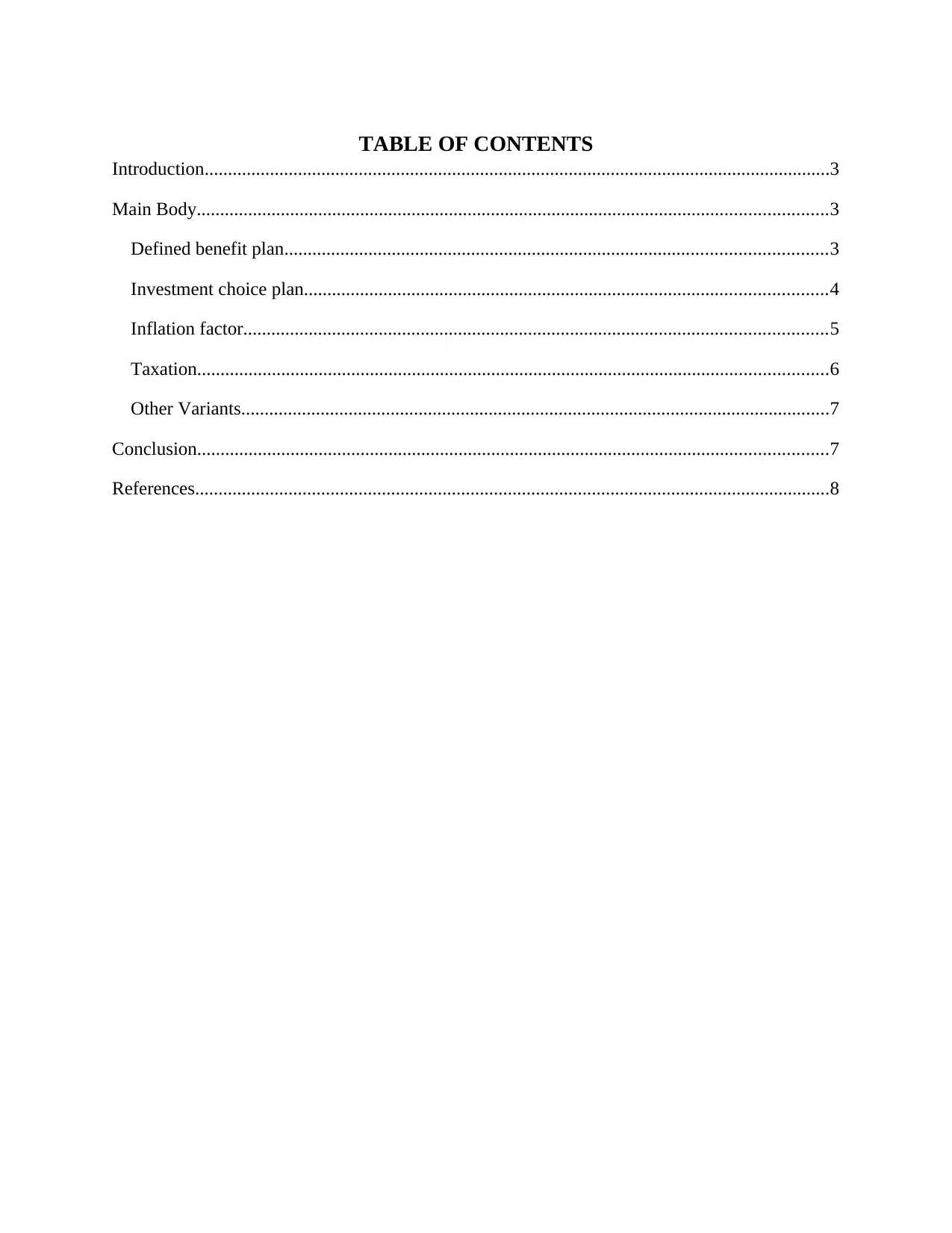
TABLE OF CONTENTS
Introduction......................................................................................................................................3
Main Body.......................................................................................................................................3
Defined benefit plan....................................................................................................................3
Investment choice plan................................................................................................................4
Inflation factor.............................................................................................................................5
Taxation.......................................................................................................................................6
Other Variants..............................................................................................................................7
Conclusion.......................................................................................................................................7
References........................................................................................................................................8
Introduction......................................................................................................................................3
Main Body.......................................................................................................................................3
Defined benefit plan....................................................................................................................3
Investment choice plan................................................................................................................4
Inflation factor.............................................................................................................................5
Taxation.......................................................................................................................................6
Other Variants..............................................................................................................................7
Conclusion.......................................................................................................................................7
References........................................................................................................................................8
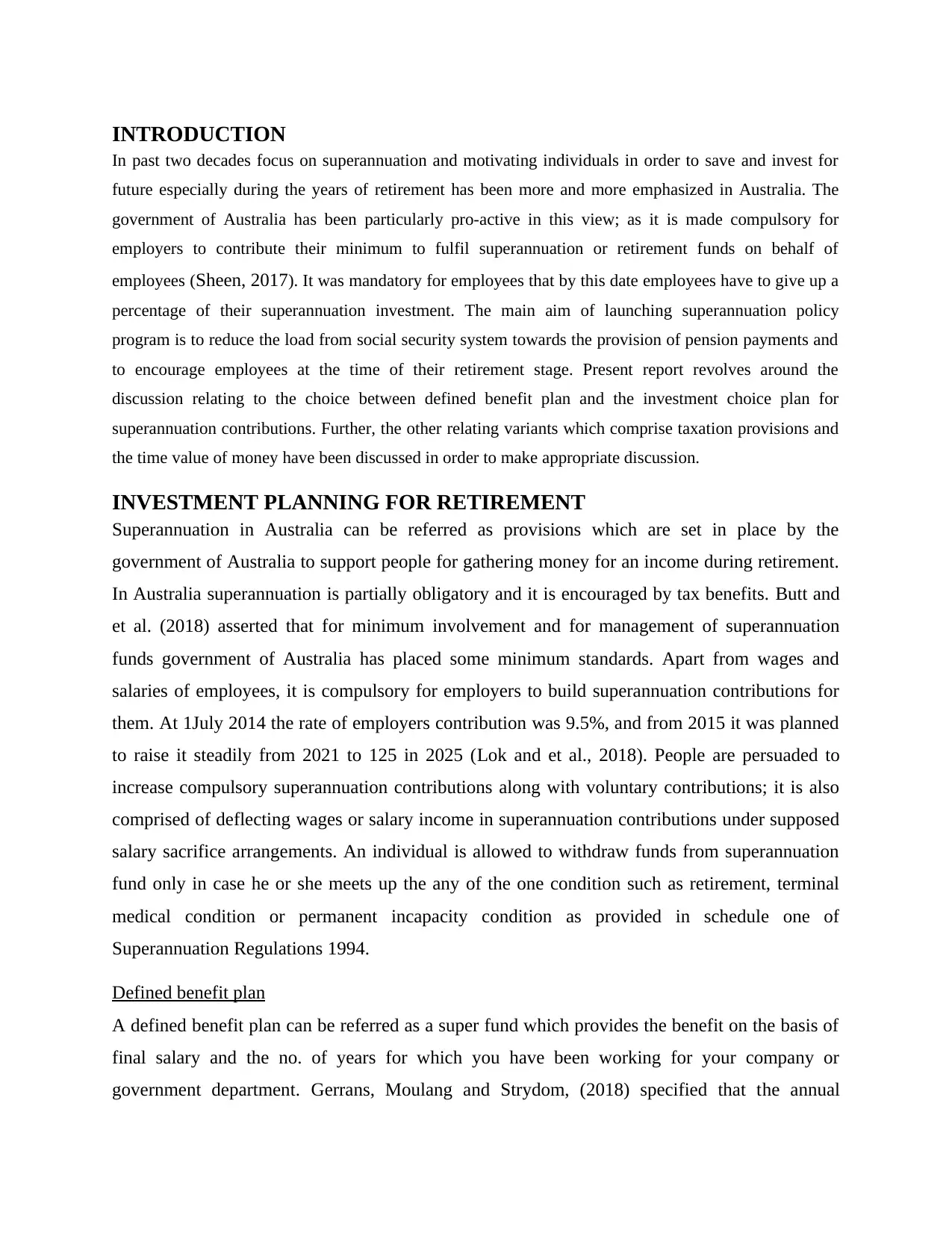
INTRODUCTION
In past two decades focus on superannuation and motivating individuals in order to save and invest for
future especially during the years of retirement has been more and more emphasized in Australia. The
government of Australia has been particularly pro-active in this view; as it is made compulsory for
employers to contribute their minimum to fulfil superannuation or retirement funds on behalf of
employees (Sheen, 2017). It was mandatory for employees that by this date employees have to give up a
percentage of their superannuation investment. The main aim of launching superannuation policy
program is to reduce the load from social security system towards the provision of pension payments and
to encourage employees at the time of their retirement stage. Present report revolves around the
discussion relating to the choice between defined benefit plan and the investment choice plan for
superannuation contributions. Further, the other relating variants which comprise taxation provisions and
the time value of money have been discussed in order to make appropriate discussion.
INVESTMENT PLANNING FOR RETIREMENT
Superannuation in Australia can be referred as provisions which are set in place by the
government of Australia to support people for gathering money for an income during retirement.
In Australia superannuation is partially obligatory and it is encouraged by tax benefits. Butt and
et al. (2018) asserted that for minimum involvement and for management of superannuation
funds government of Australia has placed some minimum standards. Apart from wages and
salaries of employees, it is compulsory for employers to build superannuation contributions for
them. At 1July 2014 the rate of employers contribution was 9.5%, and from 2015 it was planned
to raise it steadily from 2021 to 125 in 2025 (Lok and et al., 2018). People are persuaded to
increase compulsory superannuation contributions along with voluntary contributions; it is also
comprised of deflecting wages or salary income in superannuation contributions under supposed
salary sacrifice arrangements. An individual is allowed to withdraw funds from superannuation
fund only in case he or she meets up the any of the one condition such as retirement, terminal
medical condition or permanent incapacity condition as provided in schedule one of
Superannuation Regulations 1994.
Defined benefit plan
A defined benefit plan can be referred as a super fund which provides the benefit on the basis of
final salary and the no. of years for which you have been working for your company or
government department. Gerrans, Moulang and Strydom, (2018) specified that the annual
In past two decades focus on superannuation and motivating individuals in order to save and invest for
future especially during the years of retirement has been more and more emphasized in Australia. The
government of Australia has been particularly pro-active in this view; as it is made compulsory for
employers to contribute their minimum to fulfil superannuation or retirement funds on behalf of
employees (Sheen, 2017). It was mandatory for employees that by this date employees have to give up a
percentage of their superannuation investment. The main aim of launching superannuation policy
program is to reduce the load from social security system towards the provision of pension payments and
to encourage employees at the time of their retirement stage. Present report revolves around the
discussion relating to the choice between defined benefit plan and the investment choice plan for
superannuation contributions. Further, the other relating variants which comprise taxation provisions and
the time value of money have been discussed in order to make appropriate discussion.
INVESTMENT PLANNING FOR RETIREMENT
Superannuation in Australia can be referred as provisions which are set in place by the
government of Australia to support people for gathering money for an income during retirement.
In Australia superannuation is partially obligatory and it is encouraged by tax benefits. Butt and
et al. (2018) asserted that for minimum involvement and for management of superannuation
funds government of Australia has placed some minimum standards. Apart from wages and
salaries of employees, it is compulsory for employers to build superannuation contributions for
them. At 1July 2014 the rate of employers contribution was 9.5%, and from 2015 it was planned
to raise it steadily from 2021 to 125 in 2025 (Lok and et al., 2018). People are persuaded to
increase compulsory superannuation contributions along with voluntary contributions; it is also
comprised of deflecting wages or salary income in superannuation contributions under supposed
salary sacrifice arrangements. An individual is allowed to withdraw funds from superannuation
fund only in case he or she meets up the any of the one condition such as retirement, terminal
medical condition or permanent incapacity condition as provided in schedule one of
Superannuation Regulations 1994.
Defined benefit plan
A defined benefit plan can be referred as a super fund which provides the benefit on the basis of
final salary and the no. of years for which you have been working for your company or
government department. Gerrans, Moulang and Strydom, (2018) specified that the annual
⊘ This is a preview!⊘
Do you want full access?
Subscribe today to unlock all pages.

Trusted by 1+ million students worldwide
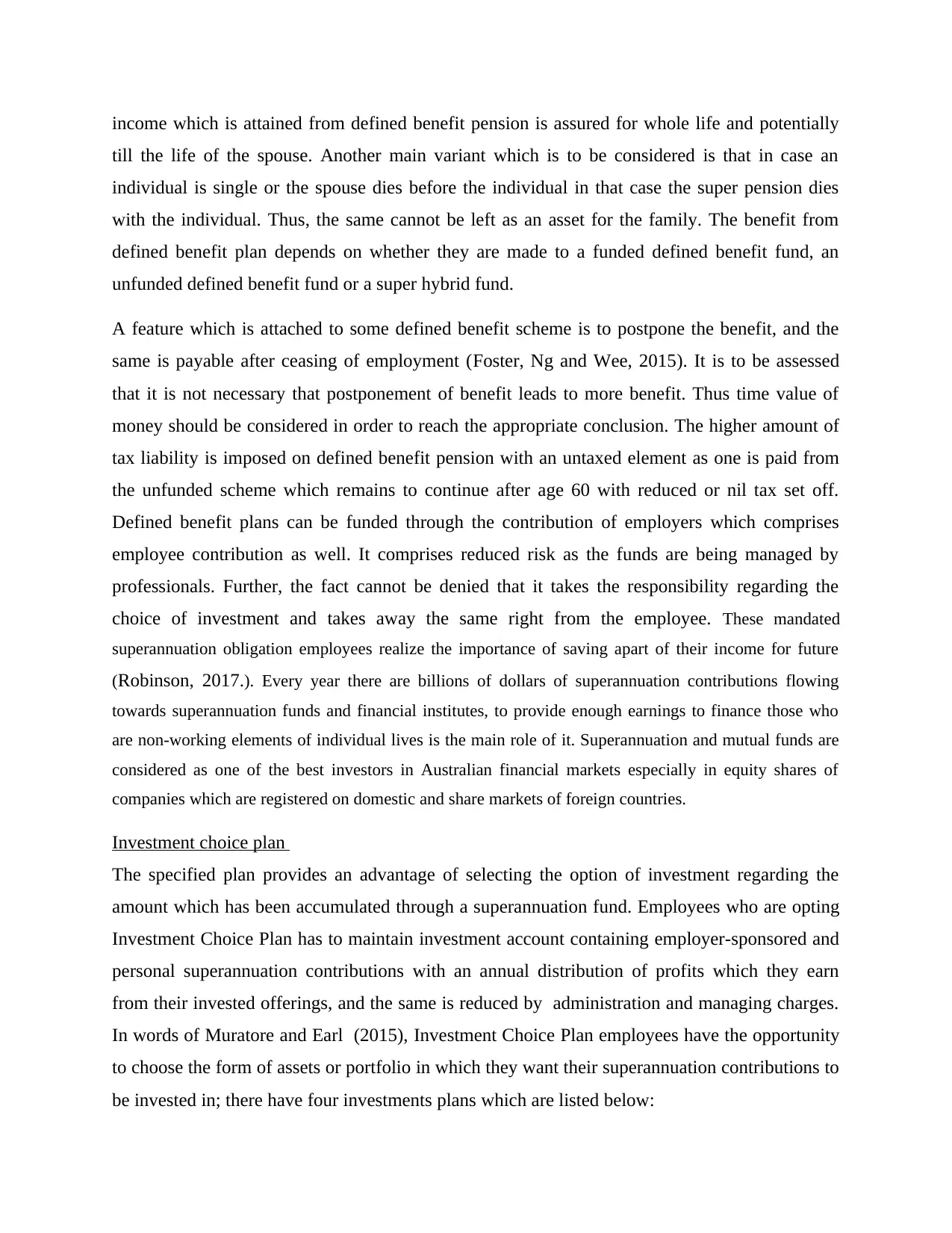
income which is attained from defined benefit pension is assured for whole life and potentially
till the life of the spouse. Another main variant which is to be considered is that in case an
individual is single or the spouse dies before the individual in that case the super pension dies
with the individual. Thus, the same cannot be left as an asset for the family. The benefit from
defined benefit plan depends on whether they are made to a funded defined benefit fund, an
unfunded defined benefit fund or a super hybrid fund.
A feature which is attached to some defined benefit scheme is to postpone the benefit, and the
same is payable after ceasing of employment (Foster, Ng and Wee, 2015). It is to be assessed
that it is not necessary that postponement of benefit leads to more benefit. Thus time value of
money should be considered in order to reach the appropriate conclusion. The higher amount of
tax liability is imposed on defined benefit pension with an untaxed element as one is paid from
the unfunded scheme which remains to continue after age 60 with reduced or nil tax set off.
Defined benefit plans can be funded through the contribution of employers which comprises
employee contribution as well. It comprises reduced risk as the funds are being managed by
professionals. Further, the fact cannot be denied that it takes the responsibility regarding the
choice of investment and takes away the same right from the employee. These mandated
superannuation obligation employees realize the importance of saving apart of their income for future
(Robinson, 2017.). Every year there are billions of dollars of superannuation contributions flowing
towards superannuation funds and financial institutes, to provide enough earnings to finance those who
are non-working elements of individual lives is the main role of it. Superannuation and mutual funds are
considered as one of the best investors in Australian financial markets especially in equity shares of
companies which are registered on domestic and share markets of foreign countries.
Investment choice plan
The specified plan provides an advantage of selecting the option of investment regarding the
amount which has been accumulated through a superannuation fund. Employees who are opting
Investment Choice Plan has to maintain investment account containing employer-sponsored and
personal superannuation contributions with an annual distribution of profits which they earn
from their invested offerings, and the same is reduced by administration and managing charges.
In words of Muratore and Earl (2015), Investment Choice Plan employees have the opportunity
to choose the form of assets or portfolio in which they want their superannuation contributions to
be invested in; there have four investments plans which are listed below:
till the life of the spouse. Another main variant which is to be considered is that in case an
individual is single or the spouse dies before the individual in that case the super pension dies
with the individual. Thus, the same cannot be left as an asset for the family. The benefit from
defined benefit plan depends on whether they are made to a funded defined benefit fund, an
unfunded defined benefit fund or a super hybrid fund.
A feature which is attached to some defined benefit scheme is to postpone the benefit, and the
same is payable after ceasing of employment (Foster, Ng and Wee, 2015). It is to be assessed
that it is not necessary that postponement of benefit leads to more benefit. Thus time value of
money should be considered in order to reach the appropriate conclusion. The higher amount of
tax liability is imposed on defined benefit pension with an untaxed element as one is paid from
the unfunded scheme which remains to continue after age 60 with reduced or nil tax set off.
Defined benefit plans can be funded through the contribution of employers which comprises
employee contribution as well. It comprises reduced risk as the funds are being managed by
professionals. Further, the fact cannot be denied that it takes the responsibility regarding the
choice of investment and takes away the same right from the employee. These mandated
superannuation obligation employees realize the importance of saving apart of their income for future
(Robinson, 2017.). Every year there are billions of dollars of superannuation contributions flowing
towards superannuation funds and financial institutes, to provide enough earnings to finance those who
are non-working elements of individual lives is the main role of it. Superannuation and mutual funds are
considered as one of the best investors in Australian financial markets especially in equity shares of
companies which are registered on domestic and share markets of foreign countries.
Investment choice plan
The specified plan provides an advantage of selecting the option of investment regarding the
amount which has been accumulated through a superannuation fund. Employees who are opting
Investment Choice Plan has to maintain investment account containing employer-sponsored and
personal superannuation contributions with an annual distribution of profits which they earn
from their invested offerings, and the same is reduced by administration and managing charges.
In words of Muratore and Earl (2015), Investment Choice Plan employees have the opportunity
to choose the form of assets or portfolio in which they want their superannuation contributions to
be invested in; there have four investments plans which are listed below:
Paraphrase This Document
Need a fresh take? Get an instant paraphrase of this document with our AI Paraphraser
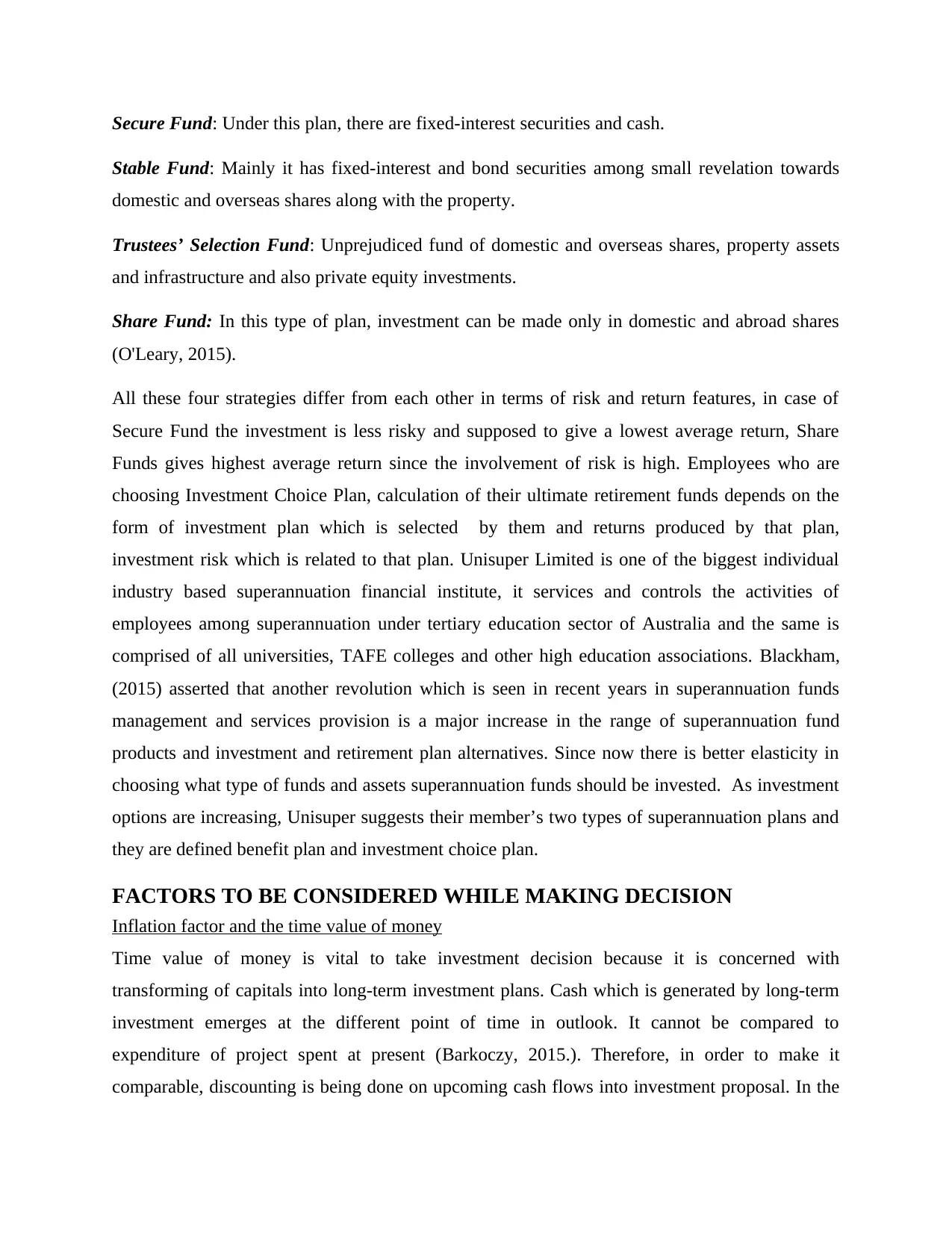
Secure Fund: Under this plan, there are fixed-interest securities and cash.
Stable Fund: Mainly it has fixed-interest and bond securities among small revelation towards
domestic and overseas shares along with the property.
Trustees’ Selection Fund: Unprejudiced fund of domestic and overseas shares, property assets
and infrastructure and also private equity investments.
Share Fund: In this type of plan, investment can be made only in domestic and abroad shares
(O'Leary, 2015).
All these four strategies differ from each other in terms of risk and return features, in case of
Secure Fund the investment is less risky and supposed to give a lowest average return, Share
Funds gives highest average return since the involvement of risk is high. Employees who are
choosing Investment Choice Plan, calculation of their ultimate retirement funds depends on the
form of investment plan which is selected by them and returns produced by that plan,
investment risk which is related to that plan. Unisuper Limited is one of the biggest individual
industry based superannuation financial institute, it services and controls the activities of
employees among superannuation under tertiary education sector of Australia and the same is
comprised of all universities, TAFE colleges and other high education associations. Blackham,
(2015) asserted that another revolution which is seen in recent years in superannuation funds
management and services provision is a major increase in the range of superannuation fund
products and investment and retirement plan alternatives. Since now there is better elasticity in
choosing what type of funds and assets superannuation funds should be invested. As investment
options are increasing, Unisuper suggests their member’s two types of superannuation plans and
they are defined benefit plan and investment choice plan.
FACTORS TO BE CONSIDERED WHILE MAKING DECISION
Inflation factor and the time value of money
Time value of money is vital to take investment decision because it is concerned with
transforming of capitals into long-term investment plans. Cash which is generated by long-term
investment emerges at the different point of time in outlook. It cannot be compared to
expenditure of project spent at present (Barkoczy, 2015.). Therefore, in order to make it
comparable, discounting is being done on upcoming cash flows into investment proposal. In the
Stable Fund: Mainly it has fixed-interest and bond securities among small revelation towards
domestic and overseas shares along with the property.
Trustees’ Selection Fund: Unprejudiced fund of domestic and overseas shares, property assets
and infrastructure and also private equity investments.
Share Fund: In this type of plan, investment can be made only in domestic and abroad shares
(O'Leary, 2015).
All these four strategies differ from each other in terms of risk and return features, in case of
Secure Fund the investment is less risky and supposed to give a lowest average return, Share
Funds gives highest average return since the involvement of risk is high. Employees who are
choosing Investment Choice Plan, calculation of their ultimate retirement funds depends on the
form of investment plan which is selected by them and returns produced by that plan,
investment risk which is related to that plan. Unisuper Limited is one of the biggest individual
industry based superannuation financial institute, it services and controls the activities of
employees among superannuation under tertiary education sector of Australia and the same is
comprised of all universities, TAFE colleges and other high education associations. Blackham,
(2015) asserted that another revolution which is seen in recent years in superannuation funds
management and services provision is a major increase in the range of superannuation fund
products and investment and retirement plan alternatives. Since now there is better elasticity in
choosing what type of funds and assets superannuation funds should be invested. As investment
options are increasing, Unisuper suggests their member’s two types of superannuation plans and
they are defined benefit plan and investment choice plan.
FACTORS TO BE CONSIDERED WHILE MAKING DECISION
Inflation factor and the time value of money
Time value of money is vital to take investment decision because it is concerned with
transforming of capitals into long-term investment plans. Cash which is generated by long-term
investment emerges at the different point of time in outlook. It cannot be compared to
expenditure of project spent at present (Barkoczy, 2015.). Therefore, in order to make it
comparable, discounting is being done on upcoming cash flows into investment proposal. In the
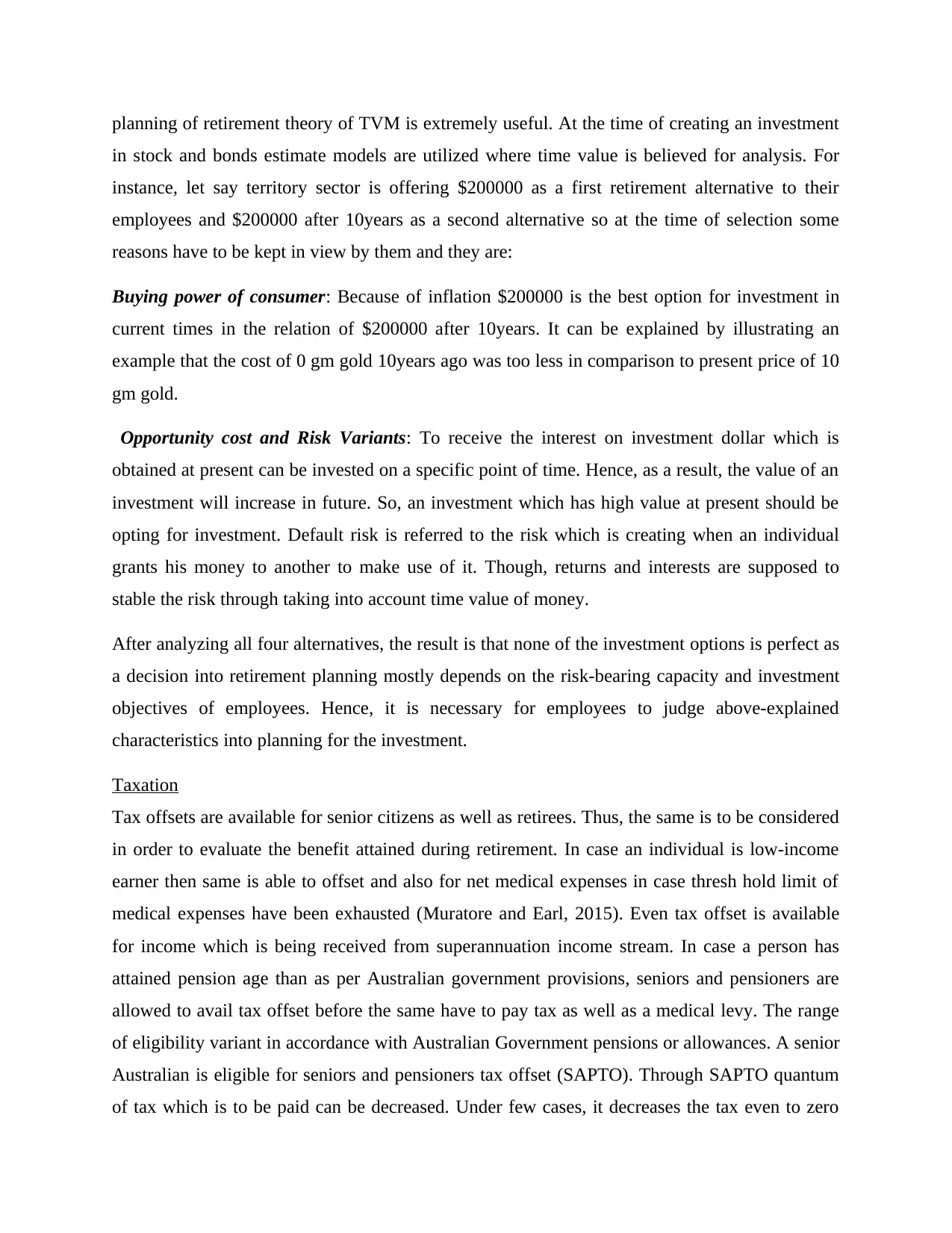
planning of retirement theory of TVM is extremely useful. At the time of creating an investment
in stock and bonds estimate models are utilized where time value is believed for analysis. For
instance, let say territory sector is offering $200000 as a first retirement alternative to their
employees and $200000 after 10years as a second alternative so at the time of selection some
reasons have to be kept in view by them and they are:
Buying power of consumer: Because of inflation $200000 is the best option for investment in
current times in the relation of $200000 after 10years. It can be explained by illustrating an
example that the cost of 0 gm gold 10years ago was too less in comparison to present price of 10
gm gold.
Opportunity cost and Risk Variants: To receive the interest on investment dollar which is
obtained at present can be invested on a specific point of time. Hence, as a result, the value of an
investment will increase in future. So, an investment which has high value at present should be
opting for investment. Default risk is referred to the risk which is creating when an individual
grants his money to another to make use of it. Though, returns and interests are supposed to
stable the risk through taking into account time value of money.
After analyzing all four alternatives, the result is that none of the investment options is perfect as
a decision into retirement planning mostly depends on the risk-bearing capacity and investment
objectives of employees. Hence, it is necessary for employees to judge above-explained
characteristics into planning for the investment.
Taxation
Tax offsets are available for senior citizens as well as retirees. Thus, the same is to be considered
in order to evaluate the benefit attained during retirement. In case an individual is low-income
earner then same is able to offset and also for net medical expenses in case thresh hold limit of
medical expenses have been exhausted (Muratore and Earl, 2015). Even tax offset is available
for income which is being received from superannuation income stream. In case a person has
attained pension age than as per Australian government provisions, seniors and pensioners are
allowed to avail tax offset before the same have to pay tax as well as a medical levy. The range
of eligibility variant in accordance with Australian Government pensions or allowances. A senior
Australian is eligible for seniors and pensioners tax offset (SAPTO). Through SAPTO quantum
of tax which is to be paid can be decreased. Under few cases, it decreases the tax even to zero
in stock and bonds estimate models are utilized where time value is believed for analysis. For
instance, let say territory sector is offering $200000 as a first retirement alternative to their
employees and $200000 after 10years as a second alternative so at the time of selection some
reasons have to be kept in view by them and they are:
Buying power of consumer: Because of inflation $200000 is the best option for investment in
current times in the relation of $200000 after 10years. It can be explained by illustrating an
example that the cost of 0 gm gold 10years ago was too less in comparison to present price of 10
gm gold.
Opportunity cost and Risk Variants: To receive the interest on investment dollar which is
obtained at present can be invested on a specific point of time. Hence, as a result, the value of an
investment will increase in future. So, an investment which has high value at present should be
opting for investment. Default risk is referred to the risk which is creating when an individual
grants his money to another to make use of it. Though, returns and interests are supposed to
stable the risk through taking into account time value of money.
After analyzing all four alternatives, the result is that none of the investment options is perfect as
a decision into retirement planning mostly depends on the risk-bearing capacity and investment
objectives of employees. Hence, it is necessary for employees to judge above-explained
characteristics into planning for the investment.
Taxation
Tax offsets are available for senior citizens as well as retirees. Thus, the same is to be considered
in order to evaluate the benefit attained during retirement. In case an individual is low-income
earner then same is able to offset and also for net medical expenses in case thresh hold limit of
medical expenses have been exhausted (Muratore and Earl, 2015). Even tax offset is available
for income which is being received from superannuation income stream. In case a person has
attained pension age than as per Australian government provisions, seniors and pensioners are
allowed to avail tax offset before the same have to pay tax as well as a medical levy. The range
of eligibility variant in accordance with Australian Government pensions or allowances. A senior
Australian is eligible for seniors and pensioners tax offset (SAPTO). Through SAPTO quantum
of tax which is to be paid can be decreased. Under few cases, it decreases the tax even to zero
⊘ This is a preview!⊘
Do you want full access?
Subscribe today to unlock all pages.

Trusted by 1+ million students worldwide
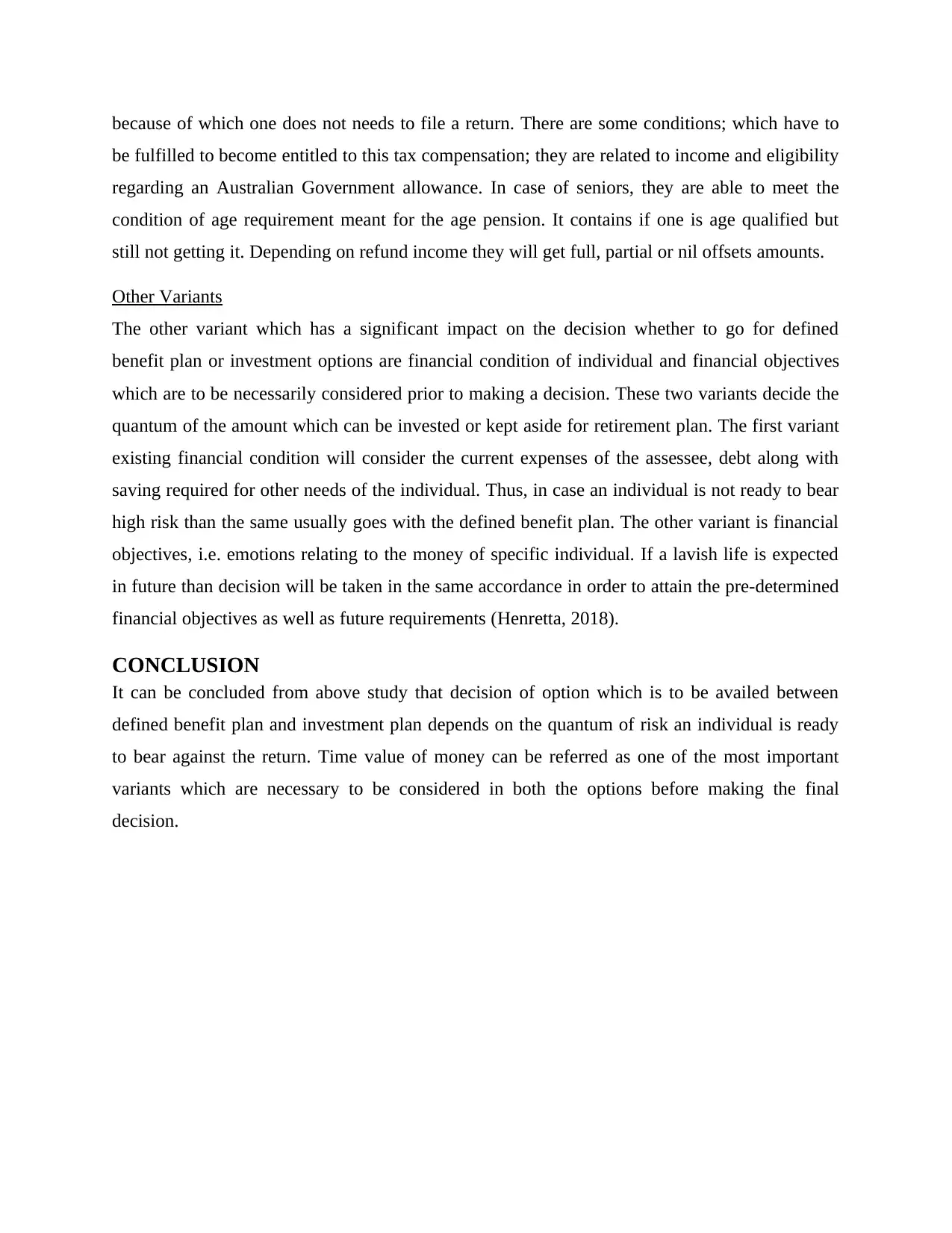
because of which one does not needs to file a return. There are some conditions; which have to
be fulfilled to become entitled to this tax compensation; they are related to income and eligibility
regarding an Australian Government allowance. In case of seniors, they are able to meet the
condition of age requirement meant for the age pension. It contains if one is age qualified but
still not getting it. Depending on refund income they will get full, partial or nil offsets amounts.
Other Variants
The other variant which has a significant impact on the decision whether to go for defined
benefit plan or investment options are financial condition of individual and financial objectives
which are to be necessarily considered prior to making a decision. These two variants decide the
quantum of the amount which can be invested or kept aside for retirement plan. The first variant
existing financial condition will consider the current expenses of the assessee, debt along with
saving required for other needs of the individual. Thus, in case an individual is not ready to bear
high risk than the same usually goes with the defined benefit plan. The other variant is financial
objectives, i.e. emotions relating to the money of specific individual. If a lavish life is expected
in future than decision will be taken in the same accordance in order to attain the pre-determined
financial objectives as well as future requirements (Henretta, 2018).
CONCLUSION
It can be concluded from above study that decision of option which is to be availed between
defined benefit plan and investment plan depends on the quantum of risk an individual is ready
to bear against the return. Time value of money can be referred as one of the most important
variants which are necessary to be considered in both the options before making the final
decision.
be fulfilled to become entitled to this tax compensation; they are related to income and eligibility
regarding an Australian Government allowance. In case of seniors, they are able to meet the
condition of age requirement meant for the age pension. It contains if one is age qualified but
still not getting it. Depending on refund income they will get full, partial or nil offsets amounts.
Other Variants
The other variant which has a significant impact on the decision whether to go for defined
benefit plan or investment options are financial condition of individual and financial objectives
which are to be necessarily considered prior to making a decision. These two variants decide the
quantum of the amount which can be invested or kept aside for retirement plan. The first variant
existing financial condition will consider the current expenses of the assessee, debt along with
saving required for other needs of the individual. Thus, in case an individual is not ready to bear
high risk than the same usually goes with the defined benefit plan. The other variant is financial
objectives, i.e. emotions relating to the money of specific individual. If a lavish life is expected
in future than decision will be taken in the same accordance in order to attain the pre-determined
financial objectives as well as future requirements (Henretta, 2018).
CONCLUSION
It can be concluded from above study that decision of option which is to be availed between
defined benefit plan and investment plan depends on the quantum of risk an individual is ready
to bear against the return. Time value of money can be referred as one of the most important
variants which are necessary to be considered in both the options before making the final
decision.
Paraphrase This Document
Need a fresh take? Get an instant paraphrase of this document with our AI Paraphraser
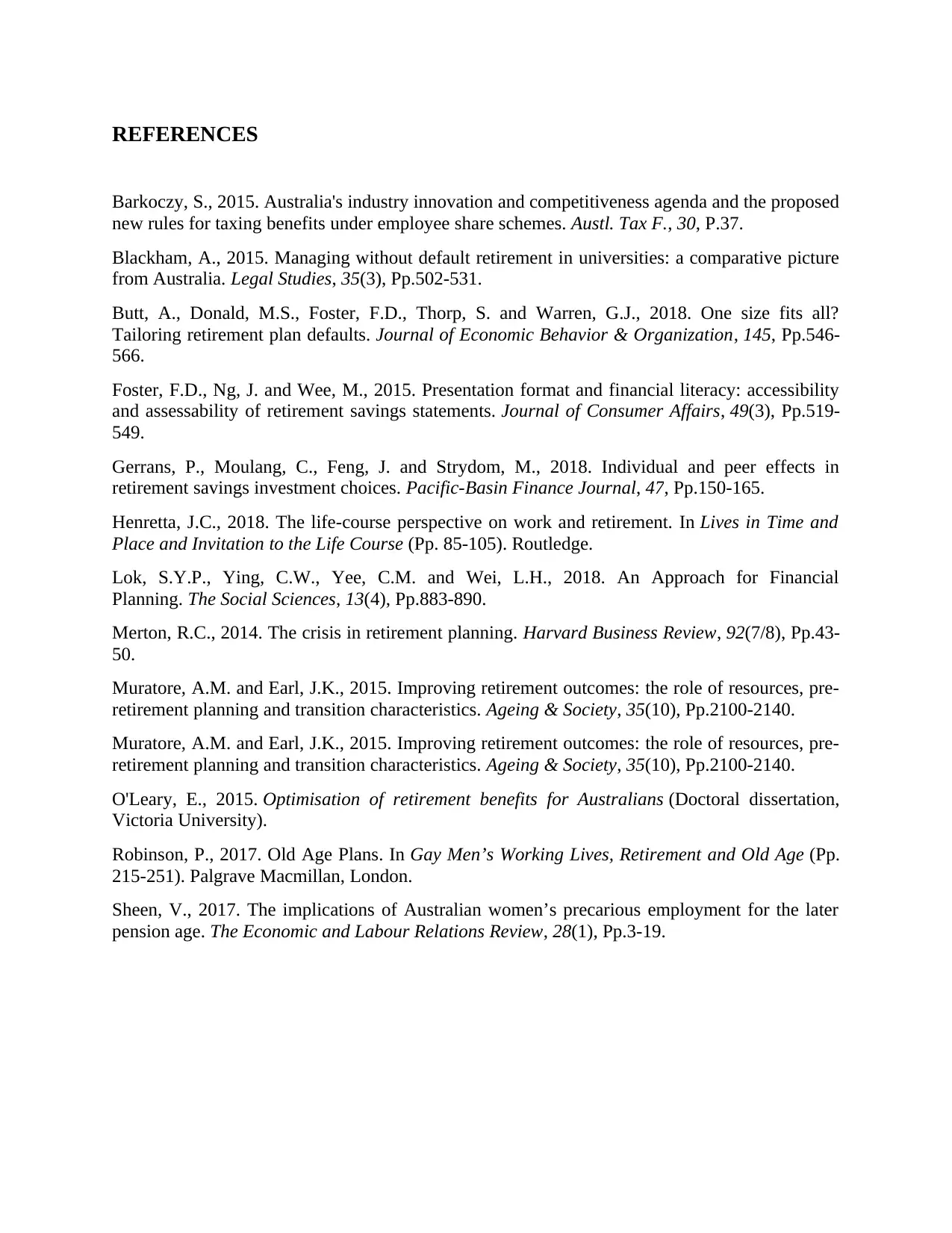
REFERENCES
Barkoczy, S., 2015. Australia's industry innovation and competitiveness agenda and the proposed
new rules for taxing benefits under employee share schemes. Austl. Tax F., 30, P.37.
Blackham, A., 2015. Managing without default retirement in universities: a comparative picture
from Australia. Legal Studies, 35(3), Pp.502-531.
Butt, A., Donald, M.S., Foster, F.D., Thorp, S. and Warren, G.J., 2018. One size fits all?
Tailoring retirement plan defaults. Journal of Economic Behavior & Organization, 145, Pp.546-
566.
Foster, F.D., Ng, J. and Wee, M., 2015. Presentation format and financial literacy: accessibility
and assessability of retirement savings statements. Journal of Consumer Affairs, 49(3), Pp.519-
549.
Gerrans, P., Moulang, C., Feng, J. and Strydom, M., 2018. Individual and peer effects in
retirement savings investment choices. Pacific-Basin Finance Journal, 47, Pp.150-165.
Henretta, J.C., 2018. The life-course perspective on work and retirement. In Lives in Time and
Place and Invitation to the Life Course (Pp. 85-105). Routledge.
Lok, S.Y.P., Ying, C.W., Yee, C.M. and Wei, L.H., 2018. An Approach for Financial
Planning. The Social Sciences, 13(4), Pp.883-890.
Merton, R.C., 2014. The crisis in retirement planning. Harvard Business Review, 92(7/8), Pp.43-
50.
Muratore, A.M. and Earl, J.K., 2015. Improving retirement outcomes: the role of resources, pre-
retirement planning and transition characteristics. Ageing & Society, 35(10), Pp.2100-2140.
Muratore, A.M. and Earl, J.K., 2015. Improving retirement outcomes: the role of resources, pre-
retirement planning and transition characteristics. Ageing & Society, 35(10), Pp.2100-2140.
O'Leary, E., 2015. Optimisation of retirement benefits for Australians (Doctoral dissertation,
Victoria University).
Robinson, P., 2017. Old Age Plans. In Gay Men’s Working Lives, Retirement and Old Age (Pp.
215-251). Palgrave Macmillan, London.
Sheen, V., 2017. The implications of Australian women’s precarious employment for the later
pension age. The Economic and Labour Relations Review, 28(1), Pp.3-19.
Barkoczy, S., 2015. Australia's industry innovation and competitiveness agenda and the proposed
new rules for taxing benefits under employee share schemes. Austl. Tax F., 30, P.37.
Blackham, A., 2015. Managing without default retirement in universities: a comparative picture
from Australia. Legal Studies, 35(3), Pp.502-531.
Butt, A., Donald, M.S., Foster, F.D., Thorp, S. and Warren, G.J., 2018. One size fits all?
Tailoring retirement plan defaults. Journal of Economic Behavior & Organization, 145, Pp.546-
566.
Foster, F.D., Ng, J. and Wee, M., 2015. Presentation format and financial literacy: accessibility
and assessability of retirement savings statements. Journal of Consumer Affairs, 49(3), Pp.519-
549.
Gerrans, P., Moulang, C., Feng, J. and Strydom, M., 2018. Individual and peer effects in
retirement savings investment choices. Pacific-Basin Finance Journal, 47, Pp.150-165.
Henretta, J.C., 2018. The life-course perspective on work and retirement. In Lives in Time and
Place and Invitation to the Life Course (Pp. 85-105). Routledge.
Lok, S.Y.P., Ying, C.W., Yee, C.M. and Wei, L.H., 2018. An Approach for Financial
Planning. The Social Sciences, 13(4), Pp.883-890.
Merton, R.C., 2014. The crisis in retirement planning. Harvard Business Review, 92(7/8), Pp.43-
50.
Muratore, A.M. and Earl, J.K., 2015. Improving retirement outcomes: the role of resources, pre-
retirement planning and transition characteristics. Ageing & Society, 35(10), Pp.2100-2140.
Muratore, A.M. and Earl, J.K., 2015. Improving retirement outcomes: the role of resources, pre-
retirement planning and transition characteristics. Ageing & Society, 35(10), Pp.2100-2140.
O'Leary, E., 2015. Optimisation of retirement benefits for Australians (Doctoral dissertation,
Victoria University).
Robinson, P., 2017. Old Age Plans. In Gay Men’s Working Lives, Retirement and Old Age (Pp.
215-251). Palgrave Macmillan, London.
Sheen, V., 2017. The implications of Australian women’s precarious employment for the later
pension age. The Economic and Labour Relations Review, 28(1), Pp.3-19.
1 out of 8
Related Documents
Your All-in-One AI-Powered Toolkit for Academic Success.
+13062052269
info@desklib.com
Available 24*7 on WhatsApp / Email
![[object Object]](/_next/static/media/star-bottom.7253800d.svg)
Unlock your academic potential
Copyright © 2020–2025 A2Z Services. All Rights Reserved. Developed and managed by ZUCOL.



